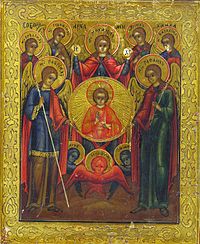The New Testament speaks frequently of angels (for example, angels giving messages to Mary, Joseph, and the shepherds; angels ministering to Christ after his temptation in the wilderness, an angel visiting Christ in his agony, angels at the tomb of the risen Christ, the angels who liberate the Apostles Peter and Paul from prison), but makes only two references to "archangels": Michael in Jude 1:9 and I Thessalonians 4:16, where the "voice of an archangel" will be heard at the return of Christ.
The Protestant Bible provides names for two archangels: Michael and Gabriel. In the Book of Tobit of the Catholic Bible, a third name, Raphael; sometimes Uriel or Phanuel is given as a fourth.
Eastern Orthodox Tradition mentions "thousands of archangels" but venerates only seven of them by name. Uriel is included, and the other three are most often named Selaphiel, Jegudiel, and Barachiel (an eighth, Jeremiel, is sometimes included as archangel). The Orthodox Church celebrates the Synaxis of the Archangel Michael and the Other Bodiless Powers on November 8 of the Eastern Orthodox liturgical calendar (for those churches which follow the Julian Calendar, November 8 falls on November 21 of the modern Gregorian Calendar). Other feast days of the Archangels include the Synaxis of the Archangel Gabriel on March 26 (April 8), and the Miracle of the Archangel Michael at Colossae on September 6 (September 19). In addition, every Monday throughout the year is dedicated to the Angels, with special mention being made in the church hymns of Michael and Gabriel. In Orthodox iconography, each angel has a symbolic representation:
- Michael in the Hebrew language means "Who is like unto God?" or "Who is equal to God?" St. Michael has been depicted from earliest Christian times as a commander, who holds in his right hand a spear with which he attacks Lucifer, Satan, and in his left hand a green palm branch. At the top of the spear there is a linen ribbon with a red cross. The Archangel Michael is especially considered to be the Guardian of the Orthodox Faith and a fighter against heresies.
- Gabriel means "Man of God" or "Might of God". He is the herald of the mysteries of God, especially the Incarnation of God and all other mysteries related to it. He is depicted as follows: In his right hand, he holds a lantern with a lighted taper inside, and in his left hand, a mirror of green jasper. The mirror signifies the wisdom of God as a hidden mystery.
- Raphael means "God's healing" or "God the Healer" (Tobit 3:17, 12:15). Raphael is depicted leading Tobit (who is carrying a fish caught in the Tigris) with his right hand, and holding a physician's alabaster jar in his left hand.
- Uriel means "Fire of God", or "Light of God" (III Esdras 3:1, 5:20). He is depicted holding a sword against the Persians in his right hand, and a fiery flame in his left.
- Selaphiel means "Intercessor of God" (III Esdras 5:16). He is depicted with his face and eyes lowered, holding his hands on his bosom in prayer.
- Jegudiel means "Glorifier of God". He is depicted bearing a golden wreath in his right hand and a triple-thonged whip in his left hand.
- Barachiel means "Blessing of God". He is depicted holding a white rose in his hand against his breast.
- (Jeremiel means "God's exaltation". He is venerated as an inspirer and awakener of exalted thoughts that raise a person toward God (III Ezra 4:36). As an eighth, he is sometimes included as archangel.)
Some Protestants view Michael as the sole archangel, as the only one explicitly described as such in the Protestant canon of the Bible. (Jude 1:9) In their view, Gabriel is never called 'archangel' in the Gospels. According to Origen, verse 1:9 of Jude is an insertion that led to the writing of The Assumption of Moses.
The edition of the Bible used by Protestants, which excludes the Apocrypha, never mentions a "Raphael" and he is therefore not recognized by many of them. Raphael, however, is mentioned in the Book of Tobit, one of the deuterocanonical books. In the story, Raphael comes to the aid of Tobit, healing him of blindness, and his son Tobias, driving away a demon that would have killed him. Raphael also plays an important role in the Book of Enoch.
Jehovah's Witnesses believe that Michael is one of the names Jesus has in heaven. In this view, Michael is the first and greatest of all God's creatures, the chief messenger of Jehovah that takes the lead in vindicating God's sovereignty, sanctifying God's name, fighting the forces of Satan and protecting God's people on earth. (Revelation 12:7; 19:14,16• Daniel 12:1) This belief is held because of the prominence Michael has among the heavenly sons of God in the Bible, the similarity of Michael’s and Jesus’ mission and the connection of Jesus with the archangelic office in 1 Thessalonians 4:16, where it is said: "Because the Lord himself will descend from Heaven with a commanding call, with an archangel's voice." Taking also into account that the Bible refers to one archangel only using a definite article (Jude 9), Jehovah's witnesses have concluded that Michael and Jesus are one and the same.
A similar opinion is held by certain Protestants, such as Seventh-day Adventists, the Baptist evangelist Charles Spurgeon and the Presbyterian Commentary author Matthew Henry, who believe that the Archangel Michael is not an angel but is instead, the divine Son of God. In this view "archangel" means "head of the angels" rather than "head angel," and is a title similar to "Prince or Leader of the host." (Daniel 8:11) While not all Baptists hold to this view, Seventh-day Adventists generally do.


Tidak ada komentar:
Posting Komentar